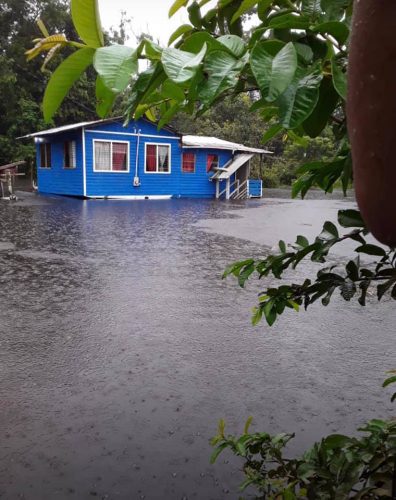With water levels reaching as high as 8 feet at Kwakwani on the Berbice River and many other flooded communities in Region 10, regional authorities are seeking to secure assistance for affected residents, including food and cleaning supplies.
Both Regional Chairman Deron Adams and Councillor for the Kwakwani community Elroy Adolph have said that residents in the communities are currently in need of food hampers and they have alerted the Civil Defence Commission (CDC) about the situation.
Excessive rainfall compounded by high tides have triggered flooding not only in Region 10 but across the country.

However in the region, communities such as Kwakwani and Aroaima, which sit on the Berbice River, have been exposed to record high levels of water.
In Kwakwani Waterfront and Lamp Island, water levels, said to be between 6 and 8 feet, were reported to have been continually rising.
From pictures seen on social media, the water was threatening some elevated homes. A poultry farmer was forced to use her canter truck as a pen to store her chickens in a bid to save them from the flooding.
“We didn’t expect the flood levels to be this high. In all my years living in this area—and people older than me have said they never saw the water so high. It is a tough situation for everyone because they are not accustomed to this,” Adolph related.
The community experienced two and half days of nonstop rain fall during the preceding two days.
According to the councillor, many residents have been caught completely by surprise by the situation.
Nonetheless, he explained that efforts are being made to establish shelter options for persons who are affected. Three families have been relocated to the shelter set up at the primary school and authorities are identifying additional buildings to be used to accommodate additional families.
Meanwhile, Adams said that he is seeking the intervention of the Ministry of Health to establish a Health Preparedness and Response team to go into the communities as soon as the water recedes.
“Many families in the flooded communities still use latrines, so our concern of a water-borne disease outbreak is high. We must have an action plan that [we] can go into immediately after the floods. We will have to get the families hygienic hampers also but the water level is too high to distribute that now,” Adams told Stabroek News.
Additionally, he stated that during discussions with government, he requested that they expedite and approve the regional infrastructure and drainage work plans.
“We have look at developing and improving the infrastructure in the region to limit disasters like this. We need our infrastructure to be upgraded because many are dilapidated and have not been rehabilitated in some years. We have to also look at measures in which we can offer relief to the households that suffer damages,” he said.
Adams earlier this week had pointed out that the region is still awaiting a response to the request directed to the Ministry of Agriculture and the National Drainage and Irrigation Authority (NDIA) for drains and creeks to be cleared of vegetation and desilted ahead of the rainy season.
“We hope that there can be some intervention from the government so that the residents can benefit from some relief from the flooding situation,” he said.
Last week, the CDC said it received reports that Kara Kara, Blueberry Hill, Block 42, Siberian Village, and Laderns ville, all experienced flooding as a result of heavy and consistent rainfall, and the overflowing of nearby creeks and rivers. Approximately 100 households and farmlands of Kara Kara were impacted. In Blueberry Hill and Block 42, numerous households were affected and residents have indicated that there were improper channels for the floodwaters to recede in a timely manner. At least 20 households were impacted in Siberian Village, but residents and members of the Com-munity Development Council cleaned the clogged drains in the area, allowing the water to recede quickly. In Ladernsville, 10 households were affected and residents there indicated that there are insufficient drains to facilitate drainage.
Meanwhile, both Adams and Adolph have sounded a warning that that the region’s developing food production sector has taken hit and that with many other places across the country also affected it is likely that the prices for basic food items will increase.
“We import 70% of our food in this region because we are not an agriculture-based region. The little crops that farmer were growing and livestock that were being reared have died. This is killing the momentum our farmers had,” Adams said.
Adolph added that residents will be challenged in the coming months to secure food.
Emphasizing that the region is not a food producer, Adolph stated that residents will be forced to pay high prices for commodities as the cost for transportation to transport goods is likely to increase after the floods.
Adolph stressed that prior to the floods, persons were already complaining of the high prices for necessities.
“There are not a lot of jobs here. Some are in logging and some have pension. Others are teachers and nurses. But you still have a lot of people who don’t work and it will be a challenge for all of these people to get food if the prices raise in the coming months,” he related.
Further, he stated that with flood waters throughout the community, movement is restricted but persons who need to get to work have to pay as much as $500 to be transported by boat.





